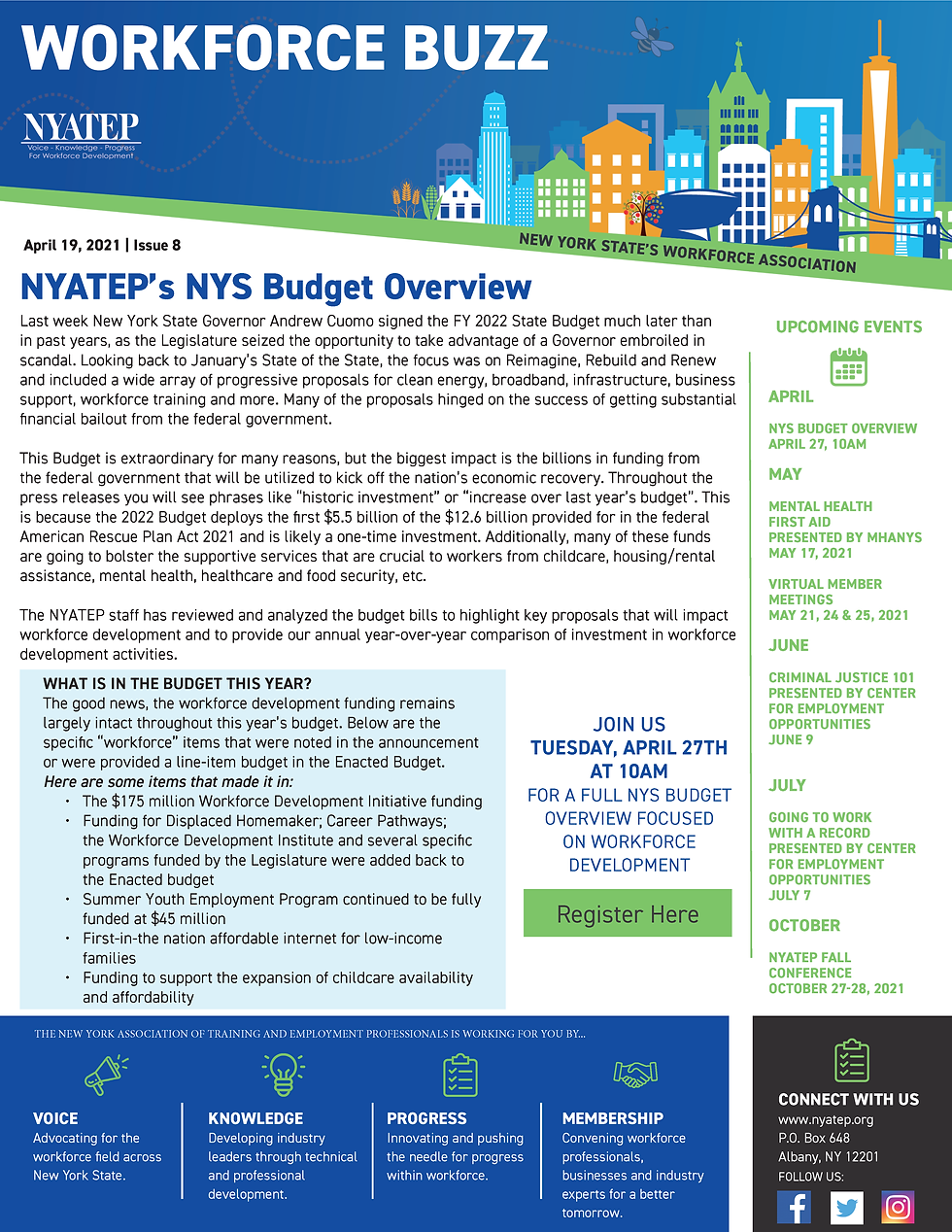NYATEP Testifies Before NYS Legislature
- Melinda Mack

- Feb 13, 2019
- 4 min read
Updated: Sep 11, 2019

Below is NYATEP's oral testimony to the Joint Legislative Budget Hearing on Economic Development presented by NYATEP's Executive Director Melinda Mack. You can read the submitted testimony.
"Good afternoon, my name is Melinda Mack, I am the executive director of New York State’s workforce development association, also known as the NY Association of Training and Employment Professionals. Thank you for the opportunity to share with you our perspective on why workforce development is a key component of the State’s economic development success.
We are at a watershed moment. New York has the chance to be a leader in shaping the future of our state’s economic growth, stability, and mobility – thereby changing the economic course of hundreds of thousands of New Yorkers.
As you all know, New York is seeing unprecedented growth statewide, however the real story lies just beneath the headlines that we have reached the “lowest unemployment rate in decades”. We are facing three key trends, that will redefine our labor market and we need to act now.
Before I go through the trends, I want to recognize that there is overwhelming support for workforce development amongst nearly all elected officials. Providing workers with the skills they need to excel in the economy; the importance of economic mobility and need to ensure employers have the workers needed to thrive are is consistently in the news. However, over the last decade our state has not been responsive to the shifts in the economy; made little to no state investments in workforce development; or have created a statewide strategy to respond to our largest economic driver: human capital.
On to the trends that you need to be aware of:
First, New York is facing a labor shortage. Across the key sectors in our labor market healthcare, education/public sector and manufacturing over a quarter of the current workforce is at or near retirement age. Additionally, all local labor markets with the exception of NYC, Long Island and the Hudson Valley have lost between 1.2% - 8.7% of their workers. However, there are people available to work – they just lack the skills needed to take the jobs being created or to move out of low wage jobs. In New York alone, 40% of people have a high school diploma or less – that is almost 8 million people who need advanced skills to be able to compete in today’s economy. This “silver tsunami” is juxtaposed with the fact that nearly all industries are growing; adding around 10,000 jobs in December alone. If we continue to grow – without investment in the human capital to replace retiring workers -- the lack of available workforce will further exacerbate the issue and cripple the state’s economic development.
Second, the vast majority of job growth in the state has been in low-wage, low-skill work. The median annual wages for New York’s fastest growing occupations is around $24,000; less than half of what it would take for a family of four to be able to make ends meet in New York. We need to attract, retain and grow good jobs. So, that New Yorkers can move up career ladders into economic self-sufficiency.
Third, we are seeing an economic revolution – with automation and the gig economy. The Rockefeller Institute estimates that nearly 4.8 million jobs will be eliminated or need to adapt, additionally 77% of the top fastest growing occupations – retail sales, food preparation, cleaners, low end healthcare occupations-- will likely be replaced with automation. The most vulnerable populations in our society generally, those with the lowest skills, are most likely to be disrupted. This has sweeping economic consequences.
I’d like to be clear that we do not have a jobs problem in our state. We have a job trajectory problem – how are we deliberate in ensuring our economic development strategy includes investing in, growing and retaining talent in New York? How do we create intentional career pathways and support employee retraining so that more New Yorkers have good jobs? These are the questions we all need to be asking of our economic and workforce communities.
Last budget cycle the Governor announced a new investment, $175 million in workforce development – including a new Consolidated Funding Application to support programmatic development and a new office of workforce development to support increased coordination across state agencies. This is incredibly promising, but this is just the start of the work we need to be doing. To provide a contrast – and to understand the scale of the investment needed – if we just focus on New Yorkers who have a high school diploma or less – not even taking into account the thousands of New Yorkers who will need to retool their skills to keep up with the changing labor market… If we invested 3 billion dollars – around what was estimated for the Amazon deal – we would have about $375 per person.
Finally, we do not need to recreate the wheel. We have regional and local workforce systems ready to scale, and partner with employers to develop strategies to help both job- and career-seekers gain the skills they need for good jobs and grow their careers. These organizations need flexibility and resources to solve problems on the ground: like transportation and childcare subsidies to enable low-income, low-skill, working New Yorkers to take advantage of training or get to a job are nearly non-existent."





Comments